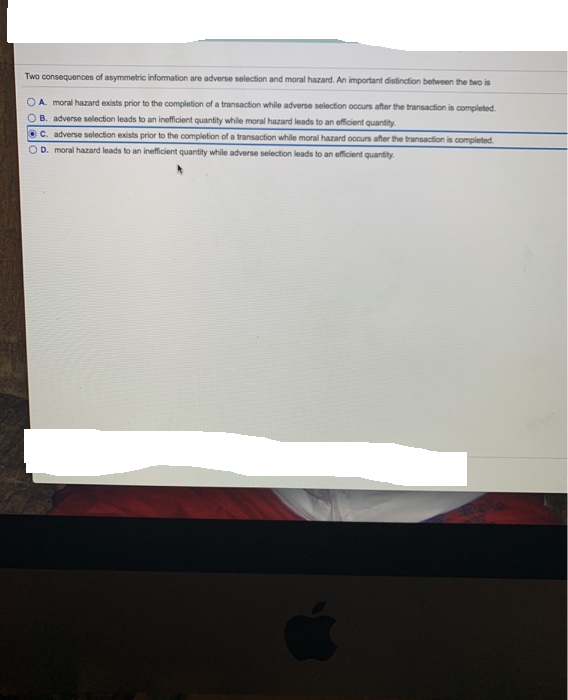Two consequences of asymmetric information are adverse selection and moral hazard. An important distinction between the two is OA moral hazard exists prior to the completion of a transaction while adverse selection occurs after the transaction is completed. B. adverse selection leads to an inefficient quantity while moral hazard leads to an efficient quantity C. adverse selection exists prior to the completion of a transaction while moral hazard occurs after the transaction is completed. D. moral hazard leads to an inefficient quantity while adverse selection leads to an efficient quantity
Two consequences of asymmetric information are adverse selection and moral hazard. An important distinction between the two is OA moral hazard exists prior to the completion of a transaction while adverse selection occurs after the transaction is completed. B. adverse selection leads to an inefficient quantity while moral hazard leads to an efficient quantity C. adverse selection exists prior to the completion of a transaction while moral hazard occurs after the transaction is completed. D. moral hazard leads to an inefficient quantity while adverse selection leads to an efficient quantity
Managerial Economics: A Problem Solving Approach
5th Edition
ISBN:9781337106665
Author:Luke M. Froeb, Brian T. McCann, Michael R. Ward, Mike Shor
Publisher:Luke M. Froeb, Brian T. McCann, Michael R. Ward, Mike Shor
Chapter19: The Problem Of Adverse Selection
Section: Chapter Questions
Problem 19.5IP
Related questions
Question

Transcribed Image Text:Two consequences of asymmetric information are adverse selection and moral hazard. An important distinction between the two is
OA. moral hazard exists prior to the completion of a transaction while adverse selection occurs after the transaction is completed.
OB. adverse selection leads to an inefficient quantity while moral hazard leads to an efficient quantity.
ⒸC. adverse selection exists prior to the completion of a transaction while moral hazard occurs after the transaction is completed.
OD. moral hazard leads to an inefficient quantity while adverse selection leads to an efficient quantity.
Expert Solution
This question has been solved!
Explore an expertly crafted, step-by-step solution for a thorough understanding of key concepts.
This is a popular solution!
Trending now
This is a popular solution!
Step by step
Solved in 4 steps

Knowledge Booster
Learn more about
Need a deep-dive on the concept behind this application? Look no further. Learn more about this topic, economics and related others by exploring similar questions and additional content below.Recommended textbooks for you

Managerial Economics: A Problem Solving Approach
Economics
ISBN:
9781337106665
Author:
Luke M. Froeb, Brian T. McCann, Michael R. Ward, Mike Shor
Publisher:
Cengage Learning


Principles of Economics 2e
Economics
ISBN:
9781947172364
Author:
Steven A. Greenlaw; David Shapiro
Publisher:
OpenStax

Managerial Economics: A Problem Solving Approach
Economics
ISBN:
9781337106665
Author:
Luke M. Froeb, Brian T. McCann, Michael R. Ward, Mike Shor
Publisher:
Cengage Learning


Principles of Economics 2e
Economics
ISBN:
9781947172364
Author:
Steven A. Greenlaw; David Shapiro
Publisher:
OpenStax

Exploring Economics
Economics
ISBN:
9781544336329
Author:
Robert L. Sexton
Publisher:
SAGE Publications, Inc